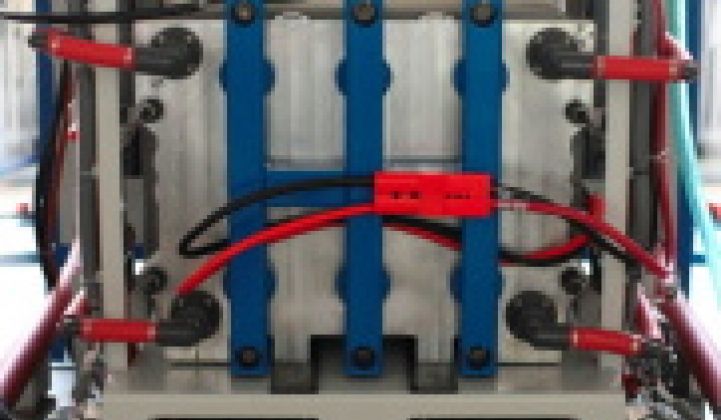Prudent Energy has landed $29.5 million in Series D funding, giving the Vancouver, B.C.-to-Beijing flow battery transplant more cash to boost its attack on grid energy storage markets in China and abroad.
The new round was led by Japan’s Mistui & Co. and included Kangoo Investment Partners, Idinvest Partners, Asia Clean Energy Limited and another Korean-based strategic investment group. Previous investors Draper Fisher Jurvetson, DT Capital Partners, Northern Light Venture Capital and CEL Partners, which invested $22 million in March 2010, also joined in this most recent round.
Prudent makes vanadium redox flow batteries, using one of a number of chemistries being put to use for large-scale energy storage units that combine aspects of traditional batteries and fuel cells. By re-circulating electrolyte through electrochemical cells, flow batteries -- which are sometimes called regenerative fuel cells -- can promise long cycle lives, though they do tend to suffer in comparison to other technologies such as lithium-ion in terms of round-trip efficiency, which measures how much energy is put into the battery as compared to what can be drawn from it.
Still, flow batteries offer a lot of promise for large-scale and reliable grid storage, with players including Enervault, Redflow (Australia), Cellstrom (EU), ZBB, EnStorage (Israel), Premium Power, and Deeya. The projects are slowly coming online, as well -- zinc-bromine flow battery startup Primus Power landed $11 million in May from Kleiner Perkins and other investors, and is building a 25-megawatt, 75-megawatt-hour energy storage system in Modesto, California.
Prudent’s funding comes close on the heels of its sale of an 8-megawatt-hour energy storage system to State Grid Corp. of China, the massive Chinese utility that controls some four-fifths of that country’s electricity market. Prudent installed a 1-mWh system for SGCC in March as part of China’s National Wind Power Integration Research and Test Center, to test its ability to capture and discharge wind power to help balance that intermittent resource’s integration with the grid.
There’s no doubt that China will need a lot of help managing its massive influx of wind power, which doesn’t produce power on a regular, predictable schedule. China plans to have 100 gigawatts of wind power online by 2015, compared to about 20 last year, and plans to invest about 300 billion yuan ($47.2 billion) per year in power grid improvements over the next decade to handle it.
While the lion’s share of that investment is in high-voltage transmission systems to carry power from wind farms in western China to population centers in the east, storage may be a beneficiary as well. China’s needs are attracting a number of energy storage companies, including flow battery startups like ZBB Energy Corp., which launched a Chinese joint venture in August, as well as lithium-ion battery heavyweight A123 Systems, which announced a 500-kilowatt storage system deal with wind turbine maker Dongfang Electric Corp. in July.
Japan remains the world leader in large-scale grid energy storage, with hundreds of megawatts of high-temperature sodium sulfur batteries made by market leader NGK to help manage the country’s wind power. Other energy storage players worth watching include AES Energy Storage, which deploys different technologies to back up grids from the United States to Chile, and solid-state battery startup Xtreme Power, which is backing up wind farms in Hawaii and working on wind farm energy storage with Duke Energy in Texas.
Still, the economics of grid-scale energy storage remain daunting, with few technologies able to compete on price against the alternative of building a gas-fired turbine to back up intermittent wind power. While market growth and resulting economies of scale may bring down prices of energy storage systems to compete with natural gas, the industry is also waiting for technological breakthroughs to help shift the curve.



